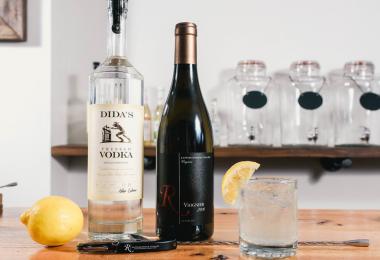Some love them for their looks. Others hate them for the mess they create. What’s certain is wax seals are sticking around, as shown by the surprising diversity of styles on the market today.
Arrayed on the table in Loire vigneron Laurent Saillard’s cellar are four small pots, containing waxes: sky blue, crimson, yellow, and black. “I just find wax seals beautiful,” he explains, echoing many artisanal winemakers of his generation.
Among retailers and consumers, however, wax seals are more controversial.
“I hate them,” says Philadelphia-based wine writer Thor Iverson. “Dealing with the mess is irritating as hell. Shattered wax is very difficult to contain.”
In the San Francisco Chronicle in 2018, Esther Mobley wrote, “I cringe as I watch the little fragments of soft, sticky wax disseminate all over my kitchen counter and floor. I fail to see how this could appeal to anyone.”
Yet wax seals continue to be adopted by ambitious wineries from California to France to the Republic of Georgia. How did such a divisive packaging style catch on?
A prestige halo
One hint is in the name of Laurent Saillard’s crimson wax colour: it is known as “Lapierre Red,” after the late Morgon vigneron Marcel Lapierre, who begin using it in 1980.
“He used to say there was a tradition of waxing bottles in the region, dating back to the monks of the Abbey of Citeaux,” explains Lapierre’s son and successor, Mathieu Lapierre. “He found it prestigious, although it was hardly appreciated by sommeliers at the time.”
For Marcel Lapierre and peers like Jean Foillard and Yvon Métras, a wax seal helped ennoble a bottle of humble Beaujolais. Many of the early natural French winemakers followed suit, from Dominique Derain in Burgundy to Domaine Gramenon in the southern Rhône, inspiring others along the way.
Domaine Lapierre, of course, is just one factor. Chablis has its own long tradition of yellow wax, upheld by renowned estates like Domaine Réné et Vincent Dauvissat and Domaine François Raveneau, followed in turn by Domaine Alice et Olivier de Moor and Domaine des Pattes Loup. Meanwhile, back in 1985, Rioja icon Don Pedro López de Heredia justified his own use of wax seals on top cuvées, writing in Cursos Rioja, “The wax seal is a solid paste with physical properties that render it unattackable by the environmental agents of the cellar.”
Today, bolstered by historical prestige, wax seals are a choice for wine producers seeking to distinguish their products on shop shelves. For many, it’s like a badge of artisanal production.
“Wax helps communicate the handmade details we include from start to finish in our wines,” says Provence vigneron Stephen Roberts, of Fondugues-Pradugues, whose biodynamic “Eau de Rosée” rosé sports a wax seal in robin’s-egg blue. “Big rosé producers simply can’t do this.”
It hasn’t stopped them from trying. Last fall saw Chile’s Concha y Toro launch their “Adorada” rosé into the UK market. It retails for £9.50 ($12.10) and boasts, according to its press release, “a hand-dipped wax seal, evoking an aesthetic more akin to high-fashion than the traditional wine aisle.”
Hand crafted
Wax seals remain scarce in supermarkets precisely because hand-dipping is so time-consuming. (Mathieu Lapierre once calculated that wax seals costs his domaine 0,11€ / bottle, including labour.) While machines exist, most winemakers persist in working by hand.
“With a few good podcasts, the process can be quite relaxing,” notes Beaujolais vigneron Michele Smith-Chapel, who waxes the seals of the wines she makes with her husband at Domaine Chapel.
As wax seals have grown in popularity, winemakers increasingly take pains to make their own wax seals more distinctive. Some, like Domaine Chapel, employ unusual colours: for the couple’s Juliènas, a sober grey. Others, like Yvon Métras, wax just the edge of the rim, an effect that is difficult to replicate with machines. Still others, like Julie Balagny or Kenji et Mai Hodgson, use translucent beeswax.
Maxime Lepeltier of Nantes-based winemaking supply company SESOL - who supply wax to Lapierre, Saillard, Roberts, and many others - confirms that red wax still makes up about 20% of his orders. “But today we explain to clients that they must differentiate themselves,” he says.
Beyond aesthetics, wax type also influences the perennial consumer concern: the ergonomics of bottle opening. SESOL and similar companies offer both traditional wax - solid and brittle - and “cirlastic,” or modern wax, produced with a dab of silicone. It is suppler and less prone to shattering.
Laurent Saillard recently switched from the former to the latter. But it wasn’t out of concerns for cleanup; he’d heard that a waiter in New York had such difficulty opening one of his wax-sealed bottles that it resulted in a hand injury and a trip to the hospital.
“No one got sued, but it could happen in America,” he says. “So I changed the wax. I was concerned where it could lead.”
That Saillard never considered abandoning wax seals entirely - despite the hassle of applying them, despite the threat of lawsuits and plenty of consumer pushback - is a testament to their enduring appeal among winemakers. Like the mess they make, wax seals are sticking around.
Aaron Ayscough
Do you have a news tip or something to announce? If so, send it to carter@meininger.de
To stay up to date with the news, subscribe to our newsletter. For in-depth, international content, subscribe to Meininger's Wine Business International magazine, available in print and online.








